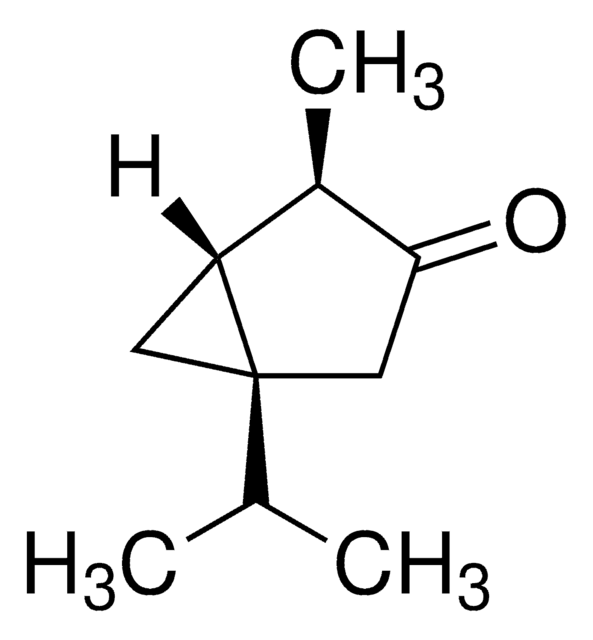W507709
L-Fenchone
≥98%
Synonyme(s) :
(1R)-(−)-Fenchone, (−)-1,3,3-Trimethyl-2-norbornanone, (−)-Fenchone, (1R)-1,3,3-Trimethylbicyclo[2.2.1]heptan-2-one
About This Item
Produits recommandés
Source biologique
synthetic
Niveau de qualité
Qualité
Fragrance grade
Halal
Kosher
Agence
follows IFRA guidelines
meets purity specifications of JECFA
Conformité réglementaire
EU Regulation 1223/2009
Pureté
≥98%
Activité optique
[α]20/D −51°, neat
Indice de réfraction
n20/D 1.461 (lit.)
Point d'ébullition
192-194 °C (lit.)
Pf
5-6 °C (lit.)
Densité
0.948 g/mL at 25 °C (lit.)
Application(s)
flavors and fragrances
Documentation
see Safety & Documentation for available documents
Allergène alimentaire
no known allergens
Allergène de parfum
no known allergens
Propriétés organoleptiques
camphoraceous; earthy; woody
Chaîne SMILES
CC1(C)C2CCC(C)(C2)C1=O
InChI
1S/C10H16O/c1-9(2)7-4-5-10(3,6-7)8(9)11/h7H,4-6H2,1-3H3/t7-,10+/m0/s1
Clé InChI
LHXDLQBQYFFVNW-OIBJUYFYSA-N
Vous recherchez des produits similaires ? Visite Guide de comparaison des produits
Catégories apparentées
Description générale
Clause de non-responsabilité
Mentions de danger
Conseils de prudence
Classification des risques
Aquatic Chronic 2
Code de la classe de stockage
10 - Combustible liquids
Classe de danger pour l'eau (WGK)
WGK 2
Point d'éclair (°F)
151.7 °F - closed cup
Point d'éclair (°C)
66.5 °C - closed cup
Équipement de protection individuelle
Eyeshields, Faceshields, Gloves, type ABEK (EN14387) respirator filter
Certificats d'analyse (COA)
Recherchez un Certificats d'analyse (COA) en saisissant le numéro de lot du produit. Les numéros de lot figurent sur l'étiquette du produit après les mots "Lot" ou "Batch".
Déjà en possession de ce produit ?
Retrouvez la documentation relative aux produits que vous avez récemment achetés dans la Bibliothèque de documents.
Les clients ont également consulté
Notre équipe de scientifiques dispose d'une expérience dans tous les secteurs de la recherche, notamment en sciences de la vie, science des matériaux, synthèse chimique, chromatographie, analyse et dans de nombreux autres domaines..
Contacter notre Service technique











